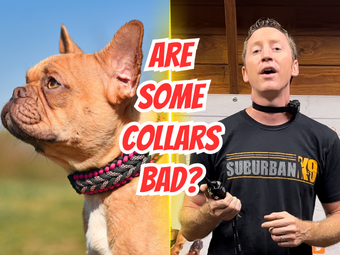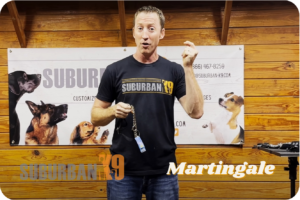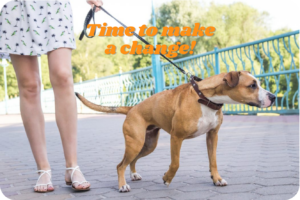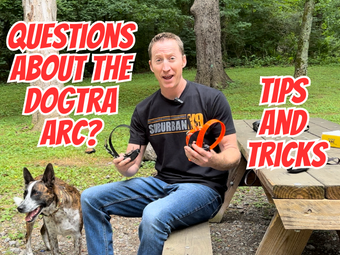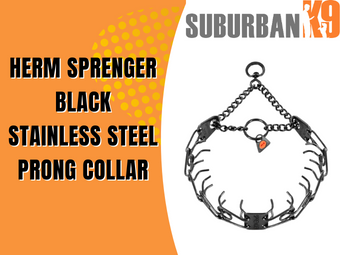Are you wondering what the best dog collar for training is? As dog trainers, we help clients choose the right collar, training tools, and equipment daily. Generally speaking, there are no good and bad collars, but some collars are better than others for certain dogs. Before choosing what collar to use, you must consider your training goals, your dog's age, temperament, and issues.
What is the best dog collar for training?
Best Dog Collars: Harness
- Lift and assist: padded and reinforced handle
- Built to last: Constructed with bluesign-certified polyester ripstop fabric
- Two durable leash attachment points
- Padded for comfort
Harnesses offer several advantages for dogs, distributing pressure more evenly across the chest and back rather than the neck. This reduces the risk of injury to the neck area and is especially beneficial for dogs prone to tracheal damage. We like the Ruffwear Web Master Harness pictured above. This harness is harder for dogs to slip out of than the harnesses that have the "cloth T" in the front of them.
The tradeoff to this safety is sacrificing control. With pressure from the leash spread out, you lose the ability to communicate with them. We teach all dogs we train how to heel. When dogs learn to walk on a loose leash, you don't need to worry about tracheal damage.
Best Dog Collars: Cloth Collar (Buckle)
- PLEASE CHECK THE PET'S EXACT NECK SIZE BEFORE YOU CONFIRM THE ORDER / Small size: 0.6"*14.5"(1.5cm*37cm), Neck 10.5-13"(27-33cm)
- Material: Leather + Alloy
- 5 adjustment holes for adjustment
- Strong and durable high quality leather, Nickel-plated hardware and heavy duty D-ring to help protect its neck
- Fashionable and personalized designed for your pet
Cloth collars are lightweight, comfortable, and suitable for everyday wear. We only recommend these on fully trained dogs, but their primary purpose is usually to hold your dog's tags.
Cloth collars with a plastic clip are prone to break, a major issue. Dogs can also easily back out of these collars when not fitted correctly. If you still want a flat collar, we suggest a leather one with a buckle type locking mechanism.
Best Dog Collars: Martingale
The Martingale collar is much better than a standard flat or cloth collar. This is one of our top 3 training tools that we use. Our favorite feature of martingales is a mesh or metal chain portion, which can tighten and loosen. This allows us to give dogs corrections or tugs that can quickly catch their attention.
Typically these are best for trained dogs but also for younger or nervous dogs. We often use these when we feel a prong collar is unsuitable.
Best Dog Collars: Slip Collar and Choke Chain
Slip collars and Choke Chains are some of our least favorite training tools on the market. Overall they are not a super great collar for the average dog. They are best suited for experienced handlers with a well trained dog. Clients can easily be too tight on the leash, causing the dog to choke.
They can do a great job of getting your dog's attention, but if they have significant issues, there are better options. When putting these on your dog, you must ensure they are not backward. A good rule of thumb is to see a "P" in the loop so it can loosen on its own.
Best Dog Collars: Prong Collar
- Features solid fastener plate, providing a more secure connection
- To adjust size, add or remove individual links
- Country Of Origin: Germany
- Item Package Weight: 0.2
- Care: For more stubborn dirt, use a little water, some mild soap, and a soft-bristled toothbrush
The prong collar is our favorite training tool for many reasons. With that said, they are not for every dog. Very timid or young dogs may not be the best fit for these collars. We recommend using only the Herm Sprenger brand. The two main versions we carry are the normal prong and quick release. We do a full review of the Herm Sprenger Prong Collar.
The standard version is much safer to use as it does not have the risk of coming off during training. We will never use a large prong size and stick to just a small or a medium. Prong collars mimic mom's nip, so when you give a tug, it is a very intuitive feeling. These collars also come with a trachea plate to keep your dog safe. Please watch this video on how how to get the best fit!
- Herm. Sprenger Prong Collar, 23 inches overall length; wire gauge 3.2 mm
- Designed for dogs with the neck circumference of Up To 19 inches
- High quality chrome plated steel; Built for safety and strength
- Features a quick release snap
- Made in Germany
Best Dog Collars: E-Collar
The last training tool we covered in this video is the E Collar. E collars are the most controversial training tool in the dog training world. However, these are some of the safest training tools you can use. Just like every training tool we discussed today, you need to know what works best for your dog while considering your training goals with them.
E collars are not just about correction (similar to a tens unit) but also have a fantastic vibration function that can get your dog's attention. Our favorite brand is Dogtra. The last important piece of advice is that we only reinforce with e collars, not teach! We want to ensure the dog respects their owners rather than just be good cause the collar is on.
There is a full review of our favorite E-Collar the Dogtra Arc in our Product Reviews Section.
- Ultimate Handsfree Control: With 127 training levels of stimulation ranging from low to high. Modes include momentary nick, constant, and high-performance pager vibration. With a range of 3/4-Mile, this e-collar is perfect for easy obedience, hunting, and K-9 Training.
- Ergonomic Slim Collar: Designed for medium to larger dogs 15+ lbs with necks 10"-22". Suitable for all breeds with mild to medium temperaments.
- Expandable Dog Training System: ARC HANDSFREE PLUS is expandable to 2-dogs with a purchase of an additional receiver and HANDSFREE SQUARE. Connect up to 14 HANDSFREE SQUARES for easy no-look controls.
- Reliable and Tough: IPX9K waterproof dog training collar engineered to withstand even the most demanding training conditions. Bright LCD screen lets you see the battery and correction levels in all lighting conditions.
- Made to Last: USA-based customer support is standing by to answer all your questions. 1-year warranty and 30-days full product return policy. Made in South Korea.
Best Dog Collar for Large Dogs:
When seeking the most suitable dog collar for larger breeds, it's paramount to consider their safety, comfort, and effective control. While various options are available, including harnesses and martingale collars, some dog owners find that prong collars can offer specific benefits when used responsibly and correctly.
For large dogs that are strong pullers or exhibit challenging behaviors during walks, a prong collar can provide enhanced control without excessive neck pressure. When part of a well-rounded training approach, prong collars can aid in teaching dogs proper leash manners and discourage unwanted behaviors.
Remember that every dog is unique, and what works best will depend on their temperament and your training goals. Before considering a prong collar or any tool, it's wise to consult with a professional dog trainer who can guide you on its proper usage.
Best Dog Collar for Pulling:
When addressing the challenge of excessive pulling during walks, selecting a suitable dog collar becomes extremely important. While various options are available, a prong collar is one consideration for effectively managing pulling behaviors. However, it's important to stress that the suitability of a prong collar depends on responsible use. Instead, we integrate them into a comprehensive training plan. This includes positive reinforcement techniques to teach your dog proper leash manners.
As with any training tool, we highly recommend you consult with a professional dog trainer before using a prong collar. A knowledgeable trainer can guide you in its appropriate use, ensuring that it aligns with your dog's needs and fosters a positive training experience.
Best Dog Collar for Puppies:
Selecting the right dog collar for your puppy is crucial in their early training and comfort. While various options are available, considering a flat cloth collar or harness can be a beneficial choice for young and growing pups.
A flat cloth collar offers lightweight comfort and the space to attach identification tags. It's vital to ensure a proper fit, with enough room for growth without being too loose. However, monitoring your puppy when wearing a collar is essential to prevent any accidental snagging.
Harnesses can also be an excellent option for puppies, particularly for breeds prone to respiratory issues. This can be especially beneficial for puppies who pull hard on a leash before we have taught them better.
Whichever collar you choose, ensure that it's properly fitted and doesn't restrict their movement. Regular adjustments may be necessary as your puppy grows to accommodate their changing size.
Conclusion: Choosing the Right Dog Collar for Training Your Companion
As a responsible dog owner, selecting the appropriate collar for your furry companion is a decision that directly impacts their comfort, safety, and overall well-being. From harnesses that distribute pressure evenly to traditional cloth collars and specialized collars designed for specific training needs, each type has its own merits.
Ultimately, the best dog collar depends on your dog's needs, behaviors, and training goals. Prioritize your dog's comfort, safety, and positive training experiences when deciding. Selecting the right collar ensures that your dog's walks are enjoyable and contribute to their growth, well-being, and happiness.
The article above contains Affiliate Links from Amazon and other companies. If you visit their site and buy the product, we will get a small commission. Please know that we only recommend products we love and would never recommend a product we think is less than great. We look at and try hundreds of products before we ever recommend them to our clients!
